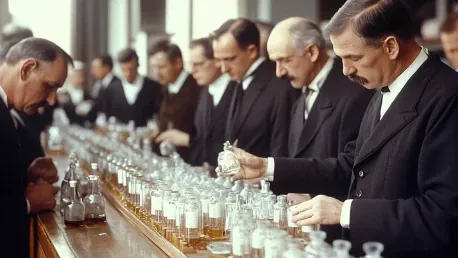The role of an 18th-century instrument maker, Francis Hauksbee the Younger, may have been pivotal in shaping the landscape of modern clinical trials. His contributions possibly influenced James Lind, a Royal Navy surgeon, whose pioneering controlled trial helped identify vitamin C as an effective treatment for scurvy, a disease that plagued sailors for centuries. This article delves into the historical evolution of clinical trials, spotlighting the often-overlooked figures who played crucial roles in establishing modern medical research methodologies.
The Pre-Clinical Trial Era
Lack of Systematic Approaches
Before the advent of controlled clinical trials, there was a significant absence of systematic approaches in comparing medical treatments. Physicians of the time often touted their remedies as universal cures, capable of treating a wide array of ailments without adverse effects. This outlook was largely supported by unchecked rhetoric rather than rigorous, evidence-based investigation. The medical landscape was dominated by anecdotal testimonies and unverified claims, and there was little structure or protocol in place to evaluate the true efficacy and safety of various treatments.
Without a formalized approach to study and compare the impacts of different treatments, the results were often unreliable and inconsistent. Medical practices varied widely, and treatments that worked in one instance might fail in another, leading to confusion and mistrust. The lack of standardized testing methods meant that physicians were often acting on intuition rather than scientific evidence. This environment set the stage for the emergence of more organized, methodical approaches to medical research, exemplified by the work of Francis Hauksbee the Younger and, subsequently, James Lind.
Medical Claims Without Evidence
The early 18th-century medical community was characterized by bold assertions regarding the effectiveness of various treatments, typically lacking any substantial evidence. Medical practitioners routinely promoted their solutions based on anecdotal successes or theoretical conjectures, often leading patients to rely on dubious treatments. This practice was widespread, allowing charlatans and well-meaning but misguided doctors alike to offer questionable therapies without accountability. The pressing need for more empirical, structured approaches to prove or disprove these claims was becoming increasingly evident.
This era’s reliance on individual testimonies and the absence of formal trials left a significant gap in the medical understanding of the time. Patients had little guarantee that proposed treatments would work, and harmful side effects were often discovered too late. These circumstances underscored the necessity for a paradigm shift towards a more scientific approach to medical research. The groundwork for this shift was laid by forward-thinking individuals like Hauksbee, who envisioned a systematic method to compare treatments and document outcomes. Their ideas would eventually inspire medical professionals to adopt controlled clinical trials, setting the foundation for modern evidence-based medicine.
Francis Hauksbee the Younger’s Contributions
An Instrument Maker’s Experiment
Francis Hauksbee the Younger, often confused with his uncle, who assisted Isaac Newton, made groundbreaking contributions to the early development of clinical trials. Unlike his more famous relative, Hauksbee the Younger was not a physician but an instrument maker and clerk at the Royal Society. Despite his non-medical background, he ventured into the realm of medical experimentation, designing an early controlled study comparing treatments for venereal disease. His new treatment for genital discharge was met with skepticism and accusations of quackery from the medical establishment, which traditionally resisted interventions from non-physicians.
Hauksbee’s innovative experiment demonstrated a methodical approach to evaluating medical treatments, which was virtually unheard of at the time. His proposed study, detailed in a paper in 1743, aimed to enlist twelve patients divided into two groups. One group would receive his new medication, while the other would receive standard treatments of the day. He stressed the importance of recording the outcomes and independently assessing the results to ensure fairness and objectivity. This method was a groundbreaking departure from the norms of the period and foreshadowed the controlled clinical trials that would become indispensable in modern medical research.
Systematic Comparison of Treatments
Hauksbee’s proposed systematic comparison of treatments marked a significant milestone in the history of medical research. By advocating for the division of patients into two distinct groups and emphasizing the need for unbiased outcome assessment, Hauksbee laid the groundwork for future clinical trials. His approach was revolutionary, as it challenged the prevailing medical practices, which typically did not involve controlled comparisons or independently verified results. The meticulous documentation of patient outcomes and the inclusion of diet and accommodation considerations in his study underscored his comprehensive approach to testing.
Although Hauksbee’s proposed trial was never actualized, his methodological innovations were crucial in shaping the principles underlying modern clinical trials. His insistence on unbiased, systematic comparisons helped shift medical research toward a more empirical, evidence-based framework. This evolution paved the way for the rigorous testing protocols that would later be championed by figures such as James Lind. Hauksbee’s contributions, though often overlooked, were integral in setting the stage for the controlled clinical trials that are now fundamental to evaluating medical treatments’ efficacy and safety.
The First Controlled Clinical Trial
James Lind’s Pioneering Work
Even though Hauksbee’s controlled trial was never conducted, his systematic approach influenced future research, including James Lind’s groundbreaking work. James Lind, a Royal Navy surgeon, sought to combat the pervasive problem of scurvy among sailors. Scouting for a viable treatment, Lind drew on earlier systematic approaches like those proposed by Hauksbee to undertake what is now recognized as the first controlled clinical trial in 1747. Lind’s trial was meticulously planned and methodically executed, involving twelve sailors stricken with scurvy, who were divided into six pairs. Each pair received one of several treatments, including cider, vinegar, seawater, oranges, lemons, and an electuary.
Lind’s trial was exemplary in its design, ensuring fair comparisons across different treatments while meticulously documenting their outcomes. Each pair of sailors was kept under similar conditions, receiving comparable forms of care except for their specific treatment. This careful attention to maintaining control and consistency was pivotal in deriving reliable results from the trial. Lind’s efforts underscored the importance of structured experimentation in medical research, highlighting the benefits of systematic methodologies that Hauksbee had previously advocated. By demonstrating the effectiveness of fruits rich in vitamin C, Lind’s work provided a crucial breakthrough in understanding and treating scurvy.
Discovery of Vitamin C’s Role
Lind’s trial yielded groundbreaking results, revealing that citrus fruits like oranges and lemons—rich in vitamin C—effectively treated scurvy. The sailors who consumed these fruits showed remarkable improvement in their health within six days, while those on other treatments experienced little to no benefit. This discovery underscored the importance of a methodical, systematic approach to medical testing, validating Hauksbee’s earlier methodological considerations. The trial’s success highlighted the necessity of controlled comparisons and unbiased assessments in determining the efficacy of medical treatments.
Lind’s pioneering work marked a significant milestone in the history of clinical research, demonstrating the tangible benefits of evidence-based medicine. His approach, influenced by earlier systematic practices, underscored the critical need for fair and comprehensive treatment comparisons. This landmark trial not only alleviated a devastating condition plaguing sailors but also laid the foundation for future clinical trials that prioritize rigorous, empirical testing over anecdotal claims. Lind’s experiment served as a testament to the enduring value of methodical inquiry and unbiased evaluation in advancing medical knowledge and improving patient outcomes.
Evolution of Clinical Trials
From Rhetoric to Evidence-Based Medicine
The evolution of clinical trials represents a significant shift from traditional medical practices reliant on rhetorical claims to a more rigorous, evidence-based approach. The importance of controlled comparisons in clinical trials cannot be overstated; these comparisons eliminate bias and ensure reliable, replicable results. Both Hauksbee’s and Lind’s methodologies exemplify this transition, highlighting the necessity of systematic and structured evaluations in studying treatment efficacy. Their work collectively underscores a broader movement within medical research, one that prioritizes empirical evidence over unverified testimonials.
This transition was not without its challenges, as early pioneers had to convince a skeptical medical community of the merits of their approaches. Despite the resistance, the clear advantages of controlled trials—such as the ability to eliminate confounding variables and the provision of unbiased, replicable data—eventually led to their widespread adoption. Today’s clinical trials, characterized by their stringent protocols, comprehensive assessments, and long-term follow-ups, are direct descendants of these early efforts. The shift to evidence-based medicine signifies an ongoing commitment to scientific rigor, accuracy, and patient safety in medical research.
Modern Clinical Trials
Modern clinical trials owe much of their structure and methodology to the early efforts of pioneers like Hauksbee and Lind. These historical trials provided invaluable lessons in crafting protocols that ensure the validity and reliability of medical research. Today, clinical trials involve meticulous planning, diverse control groups, independent assessments, and detailed record-keeping. The rigorous standards ensure that the treatments tested are backed by solid scientific evidence, minimizing the risk of harm to patients and maximizing the likelihood of identifying truly effective therapies.
The evolution of clinical trials reflects an ongoing struggle between evidence-based medicine and the dogmatic beliefs that characterized past medical practices. This shift has been essential in challenging and eventually overcoming many unfounded claims that once dominated the field. As a result, modern medical treatments are invariably based on a foundation of solid empirical evidence. This transformation has profoundly impacted healthcare, leading to safer, more effective treatments and a more scientifically grounded approach to patient care. The continued advancement of clinical trial methodologies promises even greater strides in medical research, further improving health outcomes worldwide.
Challenges and Skepticism
Professional and Social Hurdles
The history of clinical trials is also marked by the professional and social hurdles faced by early pioneers like Francis Hauksbee the Younger. The skepticism directed at non-physician experimenters reflects the broader professional dynamics and resistance to new methodologies. The London medical community’s reluctance to embrace experimental methods proposed by individuals outside the traditional medical establishment underscores these challenges. Despite these barriers, Hauksbee and his contemporaries forged ahead, driven by a commitment to scientific inquiry and the potential benefits of their work.
The professional skepticism faced by Hauksbee and others highlights the complex interplay between established authority and scientific progress. These early researchers had to navigate a landscape where innovation and non-traditional approaches were often met with suspicion or outright rejection. Nevertheless, the persistence and ingenuity of figures like Hauksbee ultimately paved the way for the acceptance and integration of controlled clinical trials into mainstream medical practice. Their efforts demonstrated the value of an open-minded, evidence-based approach to medical testing, challenging entrenched beliefs and pushing the boundaries of what was considered acceptable in medical research.
Legacy of Early Medical Researchers
The role of Francis Hauksbee the Younger, an instrument maker from the 18th century, may have been crucial in shaping the foundation of modern clinical trials. His work possibly influenced James Lind, a Royal Navy surgeon known for conducting one of the earliest controlled trials. Lind’s groundbreaking experiment in the 18th century identified vitamin C as an effective cure for scurvy, a condition that had long afflicted sailors. This article explores the historical development of clinical trials, highlighting the often-overlooked individuals who were instrumental in establishing the methodologies that underpin contemporary medical research. The journey from Hauksbee’s influence to Lind’s controlled trials marks a significant evolution in how medical research was approached. By recognizing these key contributors, we gain a deeper appreciation for the rigorous methods used today in clinical settings. Examining the contributions of these pioneers reveals the incremental advances that have collectively shaped the meticulous procedures now standard in clinical research.









